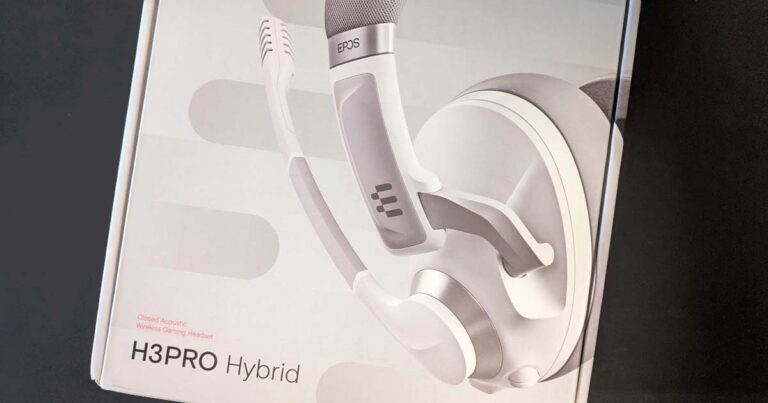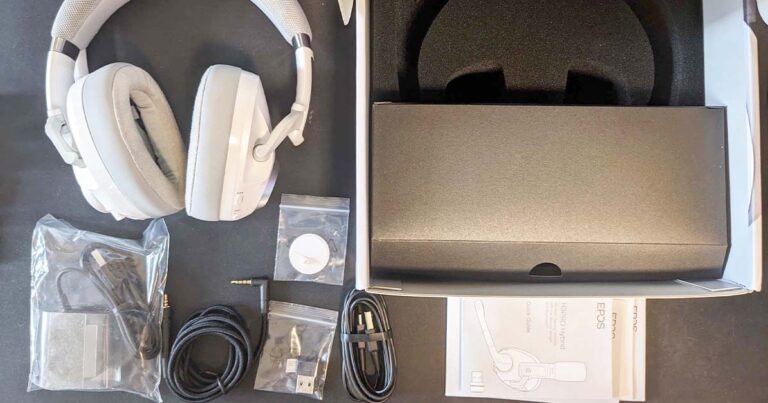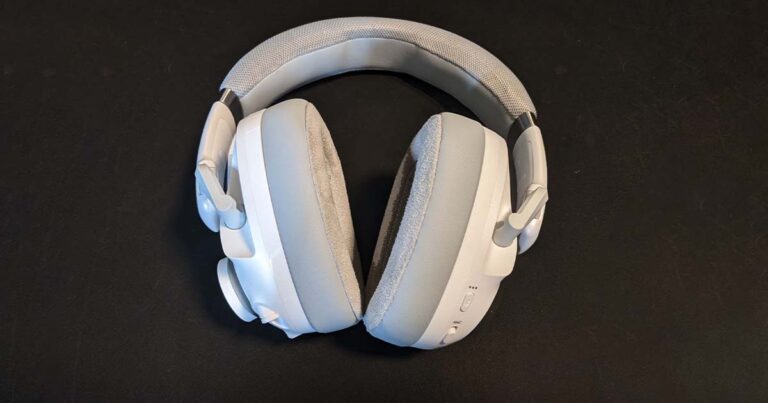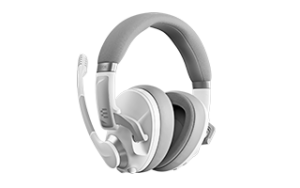A none-too-shallow asking price makes the okay performance of the Epos H3Pro Hybrid gaming headset feel below what it actually is.
Epos H3Pro Hybrid gaming headset review
As an avid PC gamer, I’m always curious to check whether a new-release gaming headset—particularly a wireless one—can topple the superiority of my go-to headsets. On the wireless (and expensive) front, there’s the god-tier SteelSeries Arctis Pro Wireless, and for wired there’s the Astro A40. For comfort and performance, nothing has come close to usurping their dominance for my head and ears.
Unfortunately for the Epos H3Pro Hybrid, that list of contenders that have fallen short now has a new entry.

How much does Epos H3Pro Hybrid cost in Australia?
Given the list of features, it’s not like the Epos H3Pro Hybrid is unreasonably priced (on paper, at least). The $399RRP is $200 cheaper than the asking price for the gold-standard four-year-old SteelSeries Arctis Pro Wireless and $150 below the asking price for the three-year-old Astro A50 Wireless. That said, the H3Pro Hybrid has identical pricing to the Logitech G Pro X Wireless (we loved the wired Logitech G Pro X precursors) and the H3Pro Hybrid is noticeably more expensive than the impressive Xbox Wireless Headset.
Still, the Epos H3Pro Hybrid has value in its versatility, including the option to easily ditch the microphone and use the headset as headphones, even if they still look like a gaming headset without the mic. Admittedly, the inclusion of active noise-cancelling switch does add versatile appeal for non-gaming applications.
Epos H3Pro Hybrid sound and comfort

On first feel, the Epos H3Pro Hybrid has a firm and snug fit, albeit one that’s not as initially comfortable as the Arctis Pro Wireless, Astro A40, Logitech Pro G X or Xbox Wireless Headset. The H3Pro Hybrid headband is easy to adjust, the microphone moves effortlessly vertically (though less so horizontally) and I had no issues fitting the earpieces around my ears.
But after multiple extended-use sessions, the Epos H3Pro Hybrid became painfully uncomfortable, particularly on my right ear for some reason. A quick adjustment mostly reset the comfort but it was still a literal pain to consistently deal with. Speaking of comfort, be careful with starting out on higher volume as these cans get loud, even if there isn’t a physical volume button for main/chat audio balance.
I’ve lamented excessive volume-limiting in the past, so consider that a big tick for the Epos H3Pro Hybrid, even if it comes with some provisos of its own. For starters, while there’s a rich soundscape in terms of highs and middles, the lows pack the kind of punch I’m used to. It means the bass is comparatively weaker when alternating between multiple headsets in explosives-rich shooters, bass-heavy music or blockbuster movie trailers. It doesn’t help that I had multiple instances where the sound sporadically dropped out, sometimes for a second and once permanently (I had to power cycle the headset to get it back).
The other volume detractor is, though the right-earcup volume dial is low-profile and easy to find every time, it feels plasticky and flimsy for a headset of this price point. You’ll get fuller sound out of the Epos H3Pro Hybrid in 2.0 mode compared to 7.1 surround when shifting between the music, esports, movie and flat (best avoided) presets.
For the record, these headset tests were performed with the latest available firmware installed, which took multiple attempts to even install via the unhelpful Epos Gaming Suite software (more on that later).
Epos H3Pro Hybrid microphone and other features

At first glance, the chunky microphone looked like it would lead to an easy win on the comms front. Unfortunately, that wasn’t the case. Feedback from those I played games with was the mic ranged from okay to “you sound like you’re in a box”, and it was difficult to find a reliable preset with the Epos Gaming Suite software.
Speaking of, that has to be one of the least favourite software companions I’ve used in a long time. Unhelpfully, even on a full charge, the Epos H3Pro Hybrid will claim it has more than 80% available, which is technically true but also not as heartening to hear 100% battery, which is more in line with what you get from other active noise-cancelling headphones, like the terribly named but admittedly incredible Sony WH-1000XM4 headphones.
You’d think the Epos Gaming Suite software would offer some guidance on battery life, and it does albeit in a squint-to-see-it kind of way. There aren’t any percentages on offer, and you’re forced to peer at a thin blue battery line against a blue background. My eyes! Admittedly, the 30-hours of battery life rings true for low-latency PC use, but the lack of transparency on actual battery levels had me reaching for the USB-C charging cable just in case.
As for the rest of the Epos Gaming Suite, there’s not a lot going on here. The headphones tab has those aforementioned four presets, plus you can add your own, as well as the option to flick between 2.0 or 7.1 soundscapes. I wish there was a physical button for this as I regularly forgot to switch to 7.1 for gaming and/or back to 2.0 for everyday audio playback.
The microphone tab has more options, but I was still unable to find a setting that made the microphone sound anything beyond the kind of average fare you accept as part and parcel of a gaming headset.
While the Epos H3Pro Hybrid does a good job of passive noise cancelling, it also has active noise cancelling, which is activated via a simple switch on the right earcup. The thing is, I play my music and games loud enough that passive noise cancelling effectively limits outside noises, and the active noise cancelling felt more subtle than profound in my day-to-day tests. While it’s a nice add-on, it doesn’t compete with the kind of noise cancelling you might expect from Bose or Sony.
More editorial, photos, test results etc.
Is the Epos H3Pro Hybrid worth buying?

The Epos H3Pro Hybrid is in a weird place. It isn’t a replacement for a dependable pair of noise-cancelling headphones and that feature feels unnecessary because of good passive noise cancelling. I like the platform versatility, but I also want a gaming headset to offer a decent microphone, big bass and all-day comfort, which are areas where the Epos H3Pro Hybrid is lacking. Ultimately, it’s not a terrible gaming headset, but spend half the price again for a truly incredible wireless headset (SteelSeries Arctis Pro Wireless) or just spend less than half the price for an admirable wireless headset that does most of what the Epos H3Pro Hybrid does anyway (Xbox Wireless Headset).
How we review gaming headsets
We factor in price and connectivity when reviewing a gaming headset, then put it through the motions of testing during hours and hours of gaming and everyday use. This also lets us determine the battery life and extended comfort of a gaming headset, as well as garner feedback on how the microphone sounds over Discord when playing with others.
Everyday testing includes video calls and music playback, and we favour headsets that are more than single-function devices. In fact, the headsets that tend to score the highest are those that marry big sound (including oomph-tastic bass) with all-day comfort. Wired and wireless gaming headsets are generally more closely compared in their respective connectivity categories, except where there’s crossover for things like comfort and sound performance.
Then we take a look at the nice-to-haves. Companion software isn’t necessarily a dealbreaker if it’s average, but it can help elevate the usefulness of a headset. We also appreciate easy-to-reach physical controls for the main functions on a headset.
Epos H3Pro Hybrid FAQs
There was a joint venture between Sennheiser and Epos, but Epos is a standalone company now, responsible for making gaming headsets.
Related Articles





